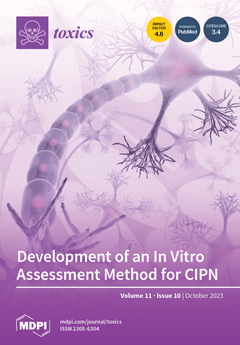Tilmicosin (TIL) is a common macrolide antibiotic in veterinary medicine. High doses of TIL can have adverse cardiovascular effects. This study examined the effects of
Rhodiola rosea (RHO) that have anti-inflammatory, antioxidant, and anti-fibrotic effects on tilmicosin (TIL)-induced cardiac injury targeting anti-inflammatory, antioxidant,
[...] Read more.
Tilmicosin (TIL) is a common macrolide antibiotic in veterinary medicine. High doses of TIL can have adverse cardiovascular effects. This study examined the effects of
Rhodiola rosea (RHO) that have anti-inflammatory, antioxidant, and anti-fibrotic effects on tilmicosin (TIL)-induced cardiac injury targeting anti-inflammatory, antioxidant, apoptotic, and anti-apoptotic signaling pathways with anti-fibrotic outcomes. Thirty-six male Wistar albino rats were randomly divided into groups of six rats each. Rats received saline as a negative control, CARV 1 mL orally (10 mg/kg BW), and RHO 1 mL orally at 400 mg/kg BW daily for 12 consecutive days. The TIL group once received a single subcutaneous injection (SC) dose of TIL (75 mg/kg BW) on the sixth day of the experiment to induce cardiac damage. The standard group (CARV + TIL) received CARV daily for 12 consecutive days with a single TIL SC injection 1 h after CARV administration only on the sixth day of study and continued for another six successive days on CARV. The protective group (RHO + TIL) received RHO daily for the same period as in CARV + TIL-treated rats and with the dosage mentioned before. Serum was extracted at the time of the rat’s scarification at 13 days of study and examined for biochemical assessments in serum lactate dehydrogenase (LDH), cardiac troponin I (cTI), and creatine phosphokinase (CK-MB). Protein carbonyl (PC) contents, malondialdehyde (MDA), and total antioxidant capacity (TAC) in cardiac homogenate were used to measure these oxidative stress markers. Quantitative RT-PCR was used to express interferon-gamma (INF-γ), cyclooxygenase-2 (COX-2), OGG1, BAX, caspase-3, B-cell lymphoma-2 (Bcl-2), and superoxide dismutase (SOD) genes in cardiac tissues, which are correlated with inflammation, antioxidants, and apoptosis. Alpha-smooth muscle actin (α-SMA), calmodulin (CaMKII), and other genes associated with Ca
2+ hemostasis and fibrosis were examined using IHC analysis in cardiac cells (myocardium). TIL administration significantly increased the examined cardiac markers, LDH, cTI, and CK-MB. TIL administration also increased ROS, PC, and MDA while decreasing antioxidant activities (TAC and SOD mRNA) in cardiac tissues. Serum inflammatory cytokines and genes of inflammatory markers, DNA damage (INF-γ, COX-2), and apoptotic genes (caspase-3 and BAX) were upregulated with downregulation of the anti-apoptotic gene Bcl-2 as well as the DNA repair OGG1 in cardiac tissues. Furthermore, CaMKII and α-SMA genes were upregulated at cellular levels using cardiac tissue IHC analysis. On the contrary, pretreatment with RHO and CARV alone significantly decreased the cardiac injury markers induced by TIL, inflammatory and anti-inflammatory cytokines, and tissue oxidative-antioxidant parameters. INF-γ, COX-2, OGG1, BAX, and caspase-3 mRNA were downregulated, as observed by real-time PCR, while SOD and Bcl-2 mRNA were upregulated. Furthermore, the CaMKII and α-SMA genes’ immune reactivities were significantly decreased in the RHO-pretreated rats.
Full article






